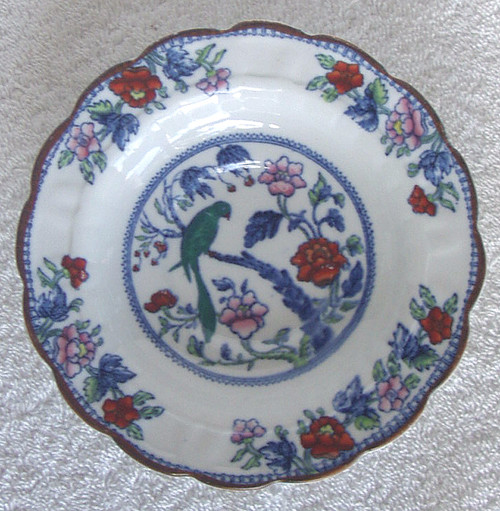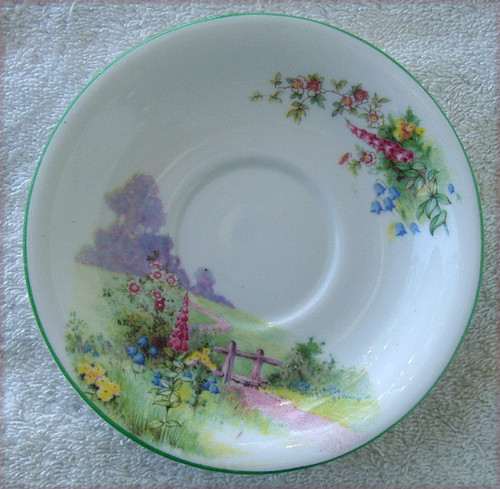Booths of Tunstall (England) began operations around the 1850's
A special feature of some Booths teawares is the name Silicon China. This was their tradename used to described a particular thin, light earthenware. Genuine Booths is opaque, not translucent.
Not a lot of Booths chinaware around these days. The central piece in the decoration is the Green parrot on a branch with the remaining decoration being dominated by a Dark Blue colouring, reminiscent of Blue Willow or Dutch Delft which gives an aire of conservatism to the artwork. Although the colours are 'strong' and bold, there is none of the typically English "flowers in springtime" feeling with their uplighting colours. This is a much more sobre decoration, probably due to the period of production - times were tough in the 1930's
BOOTHS (Tunstall) - Saucer ONLY
Silicon China
Bright White base
Opaque, meaning that if held to a light source you cannot see the shadow of your fingers through the saucer
Pattern: unknown name
Circa late 1930's (this backstamp began to be used from around 1906 but the design of this earthenware tends to suggest production was more likely in the 1930's period, particularly as I know of others in the same design that definitely came from teh 1930's period)
Hand decorated
Design: Colouring is very definitely in the style of Blue Willow, that deep rich Blue. Central area is a vivid Green parrot upon a branch and the rest of the decoration comprises groupings of different coloured flowers with foliage. The Green parrot colouring is not very common, Blue - yes but Green is difficult to find.
The edge rim is scalloped and painted in a deep Brown, NOT a metallic finish. Actually with a casual glance, this saucer looks to be very similarly decorated to a Royal Doulton of the same period.
Backstamp on the base:
BOOT HS
(Crown graphic)
Silicon China
MADE IN ENGLAND
Artist(s) marks are also clearly visible, it actually appears that two artists created the decorations.
DIMENSIONS:
145mm diameter x 30mm deep
This saucer is noticeably 'deeper' than your 'standard' English saucer, in fact we always pondered if it was actually a VERY SMALL bowl but no, it couldn't be. You wouldn't have much joy using this as a bowl and those central decorations would become damaged when using a spoon!
COSMETIC CONDITION:
Well, so how has this slice of history from 90 years ago dealt with the passage of time?
Very well indeed - not perfect but I would give this 9.5/10 if I was to rate it
USED
CLEAN
NO chips
NO cracks
NO crazing observed (both dry and wet tests)
NO fleabites
NOTE: While inspecting this saucer, I saw three small Brown marks near the underside edge - Ah Ha! I thought, but I was wrong. They are not fleabites (smooth) but some sort of very light discolouration. These marks are not serious or even obvious but I felt they should be mentioned.
Nothing is perfect in life, this saucer is no exception!
During my inspection I noticed a small, short 'scrape' mark across the Green area of the birds neck. It is not at all obvious but it is there. I could not see any other damage or flaws to the artwork.











